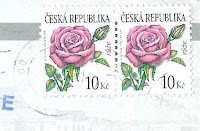Heidy contacted me sometime ago because she wanted to trade cards with me. I picked these cards from her albuns. The 1st two are from Tana Toraja in South Sulawesi and the 3rd is from Malang in Java. Tana Toraja Traditional Settlement is on the Unesco Tentative List.
Photo by Gottfried Roelcke - Impact Postcards
Tana Toraja is home to the Toraja, an ethnic group indigenous to a mountainous region of South Sulawesi. Their population is approximately 650,000, of which 450,000 still live in the regency of Tana Toraja.
These houses on the card are called Tongkonan and are the traditional Torajan ancestral houses. They stand high on wooden piles, topped with a layered split-bamboo roof shaped in a sweeping curved arc, and they are incised with red, black, and yellow detailed wood carvings on the exterior walls.
Tongkonan are the center of Torajan social life. The rituals associated with the tongkonan are important expressions of Torajan spiritual life, and therefore all family members are impelled to participate, because symbolically the tongkonan represents links to their ancestors and to living and future kin.
There are three types of tongkonan. The tongkonan layuk is the house of the highest authority, used as the "center of government". The tongkonan pekamberan belongs to the family members who have some authority in local traditions. Ordinary family members reside in the tongkonan batu. - in: wikipedia
Photo by Willy Priatmanto - Impact Postcards
On this card there's the Tau Tau, wood-carved fugures placed at the entrance to traditional Toraja grave sites.
In Toraja society, the funeral ritual is th e most elaborate and expensive event. The richer and more powerful the individual, the more expensive is the funeral. In the aluk religion, only nobles have the right to have an extensive death feast.
The ceremony is often held weeks, months, or years after the death so that the deceased's family can raise the significant funds needed to cover funeral expenses. Torajans traditionally believe that death is not a sudden, abrupt event, but a gradual process toward Puya (the land of souls, or afterlife). During the waiting period, the body of the deceased is wrapped in several layers of cloth and kept under the tongkonan. The soul of the deceased is thought to linger around the village until the funeral ceremony is completed, after which it begins its journey to Puya.
Another component of the ritual is the slaughter of water buffalo. Buffalo carcasses, including their heads, are usually lined up on a field waiting for their owner, who is in the "sleeping stage". Torajans believe that the deceased will need the buffalo to make the journey and that they will be quicker to arrive at Puya if they have many buffalo.
There are three methods of burial: the coffin may be laid in a cave or in a carved stone grave, or hung on a cliff. It contains any possessions that the deceased will need in the afterlife. The wealthy are often buried in a stone grave carved out of a rocky cliff. - in: wikipedia
Photo by Paul Zacharia - Impact Postcards
Malang is the second largest city in East Java province.
One of the icon that represents Malang city is Tugu Monument located in the center of Malang city (Jalan Tugu), that was erected in 1950.
Tugu Monument is shape of sharpened bamboo. This bamboo delineate weapon use by Indonesia to fight againts Dutch and sacrificed their life to gain independence. The chain is the the symbol of Indonesia united in one spirit to gain independence that cannot be be separated. The stairs feature 4 and 5 corners delineate year when Indonesia gained independence. Star with 4 levels and 17 bases delineate date and month of Indonesia Independence.
Tugu Monument is located in the mid of pond that is decorated with white and red lotus, symbolize of courage and purity of the heroes. On the bamboo length, there is Indonesia map and face of Bung Karno and Bung Hatta reading the proclamation text. - in: http://www.indonesia.is/places_to_visit_landmarks/tugu_monument
.jpg)

.jpg)

.jpg)
.jpg)




.jpg)
.jpg)

.jpg)
.jpg)

.jpg)
.jpg)



.jpg)

.jpg)
.jpg)


.jpg)

.jpg)
.jpg)

.jpg)
.jpg)

.jpg)


.jpg)



.jpg)
.jpg)
.jpg)
.jpg)
.jpg)
.jpg)

.jpg)
.jpg)